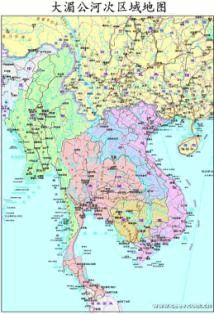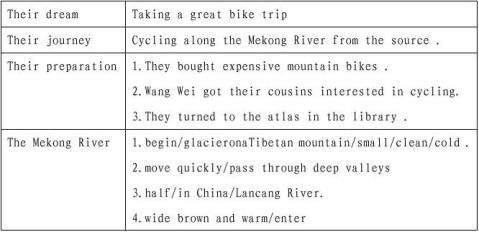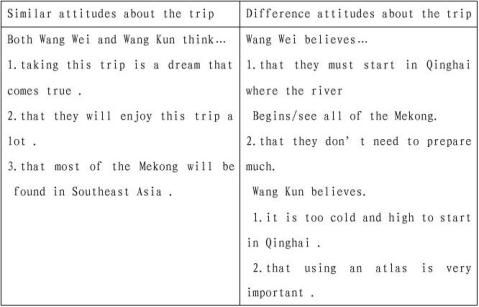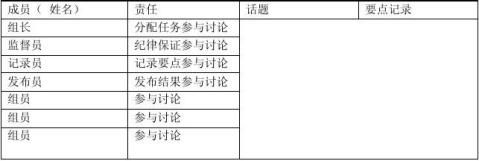格式reading journal
My Reading Journal
: Title:
After reading, I believe that Henry is really great man, he is so brilliant and tough, he deserve everybody?s respect. This man is really smart. He was born in a prosperous family farm, he showed his interest in mechanical things when he was young, and became a engineer when he grew up. His talent showed in his company and he was promoted to Chief Engineer. Ten years later, he founded his own motor company. He was also a good businessman, he made his production take up half of the world?s car market via four strategies:1.design his factory completely around assembly line.2.rise production and low prices.3.raise workers? pay.4.give back 50 dollars to each person who had bought a Ford car. His company got to be very successful at a time, but the quantity of sale went down with new competitor?s appear and Henry?s death. People in America believe he changed their lives.
The important quotations in the article is : “he was one of several automotive pioneers who helped this country become a nation of motorists.”
After reading the novel, I think my question is solved, Henry invented engine just out of fun---he like mechanical things The reading taught me that every success is not easy to achieve, if we want to be that kind of man, we must work hard. But “why Henry disagree d to let ?Model T? go at first?”remains an question for our classmates.
第二篇:Module 1 Unit3 travel journal reading
以课堂为载体培养阅读策略
NSEFC Book Unit 3 Travel Journal 的阅读课教学案例 贾剑光 义乌四中 138xxxxxxxx 人教新课标版 必修一 Unit3 Travel Journal Reading
一、教学分析
1.教学课型:阅读课
阅读部分“湄公河旅行游记”的第一部分“Part 1 The dream and the plan”讲述了王坤和王微兄妹俩的梦想,沿湄公河做自行车旅行,为之做准备的过程。
2.教学方法
任务教学法,小组合作学习,多媒体辅助教学
3.教材分析与处理
课前要求同学们通过各种渠道查询湄公河的资料,如地理位置,流域的国家,重要性等等,做好课前的准备,实际上是为了更好地理解文章特别是第三自然段做准备。文章的内容对学生比较陌生,难度上也相对较大,因此,选用了一些河流,冰川,山谷等与河流有关的图片来引起学生的兴趣。在课堂中,学生在阅读过程中,注意培养学生的阅读策略,不仅设计了略读,查读的问题,分大意题和细节题,也有深层性的问题,以各种形式呈现,如对错题,填写表格和空格,回答问题等等,引导学生积极参与课堂。特别是引导学生概括总结文章,要求写出(summary)。另外,要求学生关注高频词如(proper , finally)和小品词如(one , her )。最后,在阅读和辨认的基础上,让学生明白“有志者事竟成”和“凡事预则立”的道理。
4.学情分析
⑴所任教的学校学生英语基础相对比较薄弱,应该有梯度的设置任务,使用分层教学,提高学生的参与度,使不同层次的学生有机会展示自己,获得成就感,体验学习的快乐。
⑵如何激发学生的学习兴趣也很关键,不仅在课堂中要有大量情景的设置,而且在课外也要与学生进行情感交流,亲其师,信其言。
⑶同学们已经初步了解了阅读的几个重要技巧,如略读和查读,但是需要反复的练习和巩固。对高一新生来说,词汇量与阅读技巧都明显不足,因此阅读本篇文章会有一 1
定难度,要求学生做到充分的预习及其查阅资料,获得一定的背景知识。而且,教师必须给予指导,督促学生养成良好的学习习惯,如预习,记笔记,逐渐发展和完善学习策略。
5.教学目标
⑴语言知识:
通过有情境的课文教学,结合听说读写的语言是实践,使学生掌握课文中出现的重要的本单元的单词,短语和句子的意义和用法。
⑵语言技能:
阅读本单元课文,能够从文章中获取主要信息,并且学会写文章的概述(summary)。 ⑶学习策略:
①资源和交际策略。通过多种渠道获取更多的与湄公河有关的语言信息,从而扩大语言输入量,形成语言运用能力。
②借助联想,建立相关知识间的联系。
⑷情感态度:
通过课文的学习,要求同学们能够积极参与关于旅行准备、旅游见闻、旅游感受等方面的交流活动,用准确的英语描述国内外的重要景观、名胜古迹以及一些当地的旅游文化节日。
⑸文化意识:
了解河流对人类的作用,培养学生珍惜水资源的意识,体会“读万卷书,行万里路”的旅游文化效益。
6.培养重点和难点:
⑴培养学生良好的阅读习惯,并且加强对其阅读方法的指导。
⑵通过阅读培养学生的自学能力,使其形成有效的阅读策略。
二、教学设计
1.总体思路
本课的教学设计围绕培养学生初步读写故事类英语文章的能力特别是学习概括文章的能力展开。采用多媒体辅助教学和任务型教学,以此来创设良好的教学情境,优化教学过程,促使学生思考。采用教师指导下的发现式学习方法,启发学生自主理解文本内容,探究和领悟文章所学文章的语言特点和篇章结构,并且指导学生写概述,促使学生语言能力的提高。在辩论前,教师应该组织学生四人小组为单位进行准备,明确责任, 2
防止责任扩散。整个教学过程力求做到循序渐进,疏密结合,以利于启发学生思维和促进学生主动建构知识体系,在读,说和写的活动中发展其综合语言运用能力。 Stepl . Leading in (连一连)(2minutes)
Show them some pictures of great rivers , such as Changjiang river , Nile , Amzon , Thames and the Mekong river . Match the name of the rivers with their locations .
[设计说明] 呈现世界著名河流的图片,激发同学们的兴趣,初步进入本单元的阅读文章的主题,为下一环节做铺垫。




Step2 . Pre-reading (说一说)(5minutes)
How do people who live along a river use it ?
[设计说明] 让学生了解水资源的宝贵和对生活的重要性,培养学生珍惜水资源的意识。
Step3 . Reading (28minutes)
⑴Guessing game (猜一猜)
Show the map of the Mekong River and ask the students to guess the countries along it , such as Laos , Vietnam , Thailand . The name “Mekong” means “ mother of river “.
[设计说明]看地图,进一步了解湄公河的地理位置,并了解流域的国家。

⑵Scanning Skimming –(读一读)
Mainly it tells us that Wang Kun and Wang Wei dream about taking a bike trip down the Mekong River and how they get ready for it . Scan the passage and answer the following questions .
Q1 Who are Wang Kun and Wang Wei ?
3
Q2 What was their dream?
Q3 Who are Dao Wei and Yu Hang ?
Q4 Where is the source of the Mekong River and which sea does it enter ? Q5 How did they prepare for the trip ?
[设计说明]迅速浏览文章,了解文章大意,培养学生的阅读技巧和策略。
⑶Detail reading
①True or false questions .(判一判)
Wang Kun and Wang Wei had the chance to take a bike trip when they graduated from middle school .(False)
Wang Wei’cousins , Dao Wei and Yu Hang , are Dai people.(True)
The source of the river is in Qinghai Province and it enters East China Sea.1.(False)
All parts of the river are in China.1.(False)
You can see glaciers , rapids , hills , valleys waterfalls and plains along the river .(True)
It is not difficult to cycle along the Mekong River.1.(Fakse)
②Fill in the form and blanks(填一填)
Complete the form Activity Sheet(1)

4
Fill in the blanks Activity Sheet⑵

[设计说明]通过各种任务来完成文章的细读工作,既丰富了课堂的形式,让学生在各种活动中理解文章,并且降低了文章的难度,又激发了学生的兴趣,使得学生也紧张的参与课堂的活动中来。另外,让学生学会通过图表等方式有效地组织和处理信息,提高信息处理能力。用表格的形式呈现文章的概述和细节使文章内容具体化,简约化和系统化,有利于训练学生查找关键词这一阅读技能和策略,也有利于发展和完善其认知能力。 ⑷Summary writing(写一写)
Write a summary based on the two forms above .
Show some samples from students to the whole class .
[设计说明]通过读导入到写,有输入,有输出,符合语言学习的规律,也让学生感到有材料可写,用词基本上为本单元中重要的词和短语及其句子,把语言知识和语言技能很好地结合了起来。
Step4.Discussion(辩一辩) (10minutes)
Students Work in pairs to discuss the following open question :
Is it a difficult journey to cycle along the Mekong? Why?
[设计说明]通过讨论,让学生明白做一件事情要有充分的准备(preparation),凡是预则立,并且要下决心(make up one’s mind),碰到困难要意志坚定(determined)。“Where there is a will , there is a way”。
5
Step4.Homework
1.Practice speaking out the summary of the reading text .
2.Write a passage about the result of the discussion .
三、教学反思
教学亮点
1.所设计的教学步骤符合任务型教学,整堂课以阅读为主,听说写为辅,注重实效型,
既扩大了词汇量,又提高了阅读技能。
2.充分利用丰富的网络教学资源,课前要求学生查询湄公河的资料,许多同学以打印
稿的形式上交,内容丰富,体现了新课程中的资源策略。课内信息量大,并且融合了地理知识,体现了英语教学中的大融合教学。
3.在辩论环节,明确可各小组成员的责任与角色,如组长,监督员,记录员,避免责
任扩散,真正做到了小组合作学习和有效教学。
不足之处
1.在情景创设上稍显薄弱,师生互动不够深化。如在辩论中,发言人在唇枪舌剑时,
有些基础薄弱的同学未能积极地参与。教师应适时地引导和鼓励。
2.教师对学生的评价不够充分,激励机制没有贯穿始终。仅限于言语的表扬是不够的,
应该设立最佳辩手等荣誉称号。
四、结束语
对基础薄弱的同学而言,关键要让他们对英语学科产生兴趣,建立信心,这就需要
老师的情感教育和不断引导,提供方法指导,强化学习习惯,这些都是任重而道远。
【参考文献】
⑴《英语课程标准解读》江苏教育出版社
6

-
Diogenes and Alexander 翻译
Lesson18DiogenesandAlesander他躺在光溜溜的地上赤着脚胡子拉茬的半裸着身子模样活像个乞丐或疯子可他就是他…
-
Diogenes and Alexander 戴奥吉尼斯和亚历山大
GilbertHighetThisarticlebythelateclassicistGilbertHighetdescribesameetingbe…
-
Diogenes and Alexander retelling第欧根尼和亚历山大
ThepassagecanbedevidedintotwopartsthefirstparttalksaboutDiogenesthesecondpa…
-
大学英语(四)Diogenes and Alexander 戴奥吉尼斯和亚历山大
DiogenesandAlexander戴奥吉尼斯和亚历山大TheDogHasHisDayGilbertHighetThisart…
-
Thoughts After Diogenes and Alexander
TheQuestThatNeverEndsThisessayontheencounterofDiogenesandAlexanderisreallyt…
-
translation journal 范本
原文检点我们的幸福感在重复的岁月里我们渐渐有点摸不着过年的幸福了不少人觉得过年没劲还有几分无奈和麻木这个时候检点我们的幸福感就显得…
-
Learning Journal
Thistermwemainlyfocusedonacademicwritingandlearnthowtoanalyzeapaperwhatsmor…
- Reading Journal 英语读书笔记格式